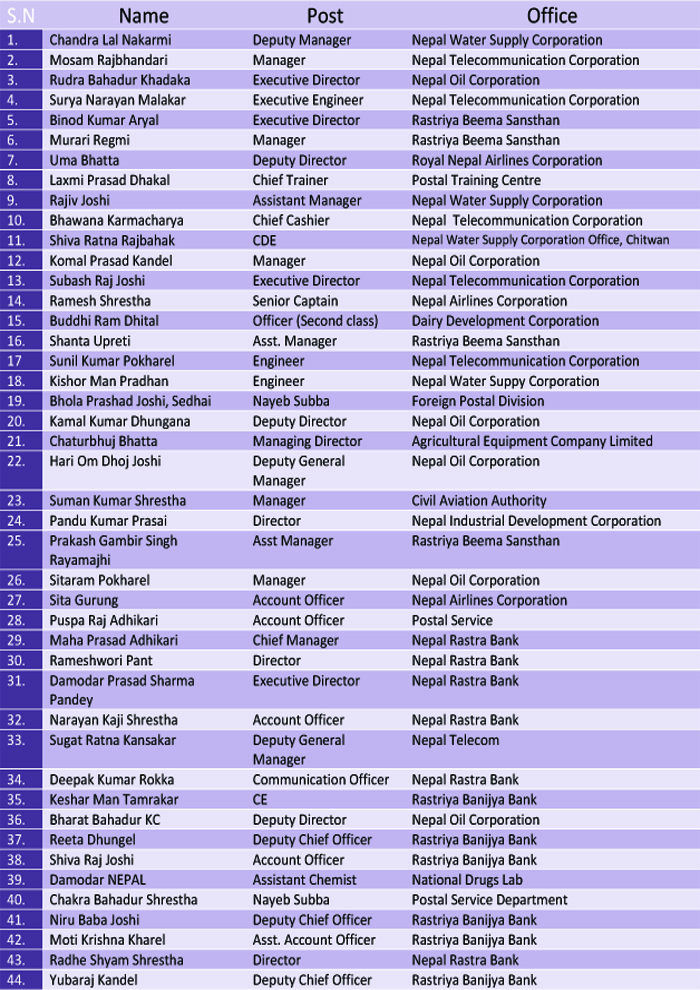0%

KATHMANDU: A total of 39 public enterprises are functioning in Nepal at this moment. Of these, 26 are managing to survive economically while 11 enterprises are running into financial loss.
Majority of the public enterprises which are posting high debit account every passing year are on the verge of closure and collapse. The latest Economic Survey released by the government for the fiscal year 2018/19 says of a total of 39 public enterprises, only 26 are financially viable.
These 26 public enterprises have posted the profit of Rs 43.45 billion while other 11 enterprises are reeling under financial loss. As the survey reveals, only two out of 39 public enterprises are out of operation. The fiscal year 2073/074 too had listed only 26 public enterprises posting profits every year. According to the survey, the government’s financial contributions have gone up to the extent of Rs 237 billion in the form of ‘share investment’.
The government has lent money (as a loan) to the tune of Rs 164.4 billion for reviving these loss-making enterprises. Even as the news regarding prospects of financial the revival of these companies came into light, hundreds of officials holding the responsible positions in these public enterprises have been found to be engaged in financial irregularities.
They have worth billions of personal property and ‘bank balance’ with no valid sources of income legally justified. The Commission for the Judicial Investigation of Property formed in 2058 BS under the chair of former Supreme Court Justice Bhairab Prasad Lamsal in its report revealed that most of the public enterprises were brought to the brink of financial collapse because of their corrupt staff and high officials.
The Lamsal Commission had then investigated 30,599 public officials of their property details along with the sources of the wealth – both moveable and immovable. Around 602 public officials were found to have amassed wealth beyond their known sources of income. Despite the report of Lamsal Commission and its recommendation for further actions, the CIAA (Commission for Investigation of Abuse of Authority) withheld the actions against the officials accused of amassing huge wealth (due to political pressure mounted on corruption watch-dog to save the highly placed officials).
The names of the corrupt officials who are bleeding the public enterprises of worth several hundred billion by being cynosures of the government are being given here:

The public enterprises and other organizations involved in the areas of trade, business, service, social work, public distribution system, and financial institutions are full of corrupt practices and other irregularities taking place right under the nose of the government and in likelihood with the consent of political masters.
Six public enterprises such as Agro-product Company Ltd, National Seeds Vision Company, Nepal Food Corporation, Nepal Oil Corporation, and Timber Corporation are involved in trading. The Civil Aviation Authority of Nepal, Nepal Airlines Corporation, National Productivity, and Economic Development Centre Ltd, Nepal Transportation, and Warehouse Management Company Ltd and Industrial Area Management Ltd are five service providing public institutions.
It is because of malpractices and unprofessional attitude of corrupt officials that the Civil Aviation Authority of Nepal is running into huge losses. In the area of social work, Nepal has all the public institutions posting losses every year except the famous Gorakha Patra. Institute of Cultural Affairs, Janak Shiksha Samagri, Nepal Television, and the National Housing Company, are under financial duress. The debt accumulation of these public institutions has already crossed the limit of Rs 3.25 billion.
Nepal Telecom Authority, Nepal Electricity Authority, Electricity Production Company Ltd, National Broadcasting Grid Company Ltd, and Nepal Water Supply Corporation are engaged in making public utilities available to people.
Both the Nepal Electricity Authority and Electricity Production Company Ltd are yet to make a profit and stand on the firm feet of business stability.
Public financial institutions of Nepal are also not that successful economically all because of corrupt staff serving their personal interests. Agricultural Development Bank Ltd, National Commerce Bank, Nepal Bank, National Insurance Organization, Beema Company Ltd, Deposits and Debts Security Fund, Nepal Stock Exchange Ltd, Citizens Investment Fund, Hydroelectricity Investment and Development Company Ltd are not that robust financially as they are expected to be, thanks to the officials managing the affairs of these public institutions and companies.
Janak Shiksha Samagri Kendra, Milk Development Authority, Nepal Drinking Water Authority, and Medicine Ltd, among others, are way below their level of economic sustainability. The incumbent government hardly bothers to audit their accounts and does not apply the tenets of proven principles of finance and management resulting in such a sorry state of these companies.